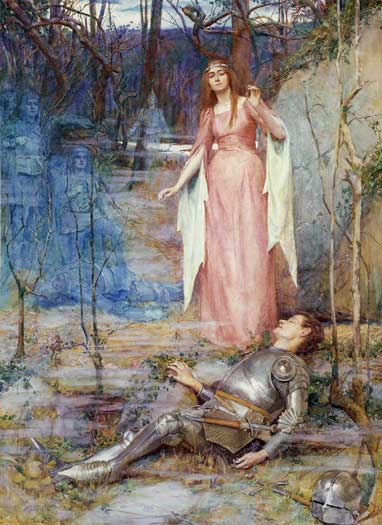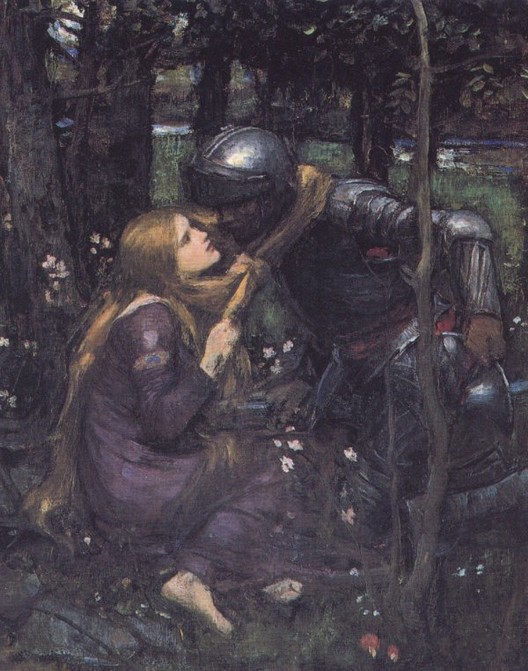
The painting above is Henry Meynell Rheame's watercolor La Belle Dame sans Merci (1901). It really is amazing how many British painters were inspired by Keats' poem. Here are just a few that we looked at. Let's start with J.W. Waterhouse's painting from 1893:

There is also Sir Frank Dicksee's 1902 interpretation.
 I could go on forever....but there are other interesting angles to find. Keats' "La Belle Dame sans Merci" and Coleridge's "The Ancient Mariner" are both in ballad format. See Conrad Geller's article on the ballad form: http://www.writing-world.com/poetry/ballad.shtml
I could go on forever....but there are other interesting angles to find. Keats' "La Belle Dame sans Merci" and Coleridge's "The Ancient Mariner" are both in ballad format. See Conrad Geller's article on the ballad form: http://www.writing-world.com/poetry/ballad.shtmlHere is Prof. Lilia Melani's definition of the ballad:
Ballad: a relatively short narrative poem, written to be sung, with a simple and dramatic action. The ballads tell of love, death, the supernatural, or a combination of these. Two characteristics of the ballad are incremental repetition and the ballad stanza. Incremental repetition repeats one or more lines with small but significant variations that advance the action. The ballad stanza is four lines; commonly, the first and third lines contain four feet or accents, the second and fourth lines contain three feet. Ballads often open abruptly, present brief descriptions, and use concise dialogue.
The folk ballad is usually anonymous and the presentation impersonal. The literary ballad deliberately imitates the form and spirit of a folk ballad. The Romantic poets were attracted to this form, as Longfellow with "The Wreck of the Hesperus," Coleridge with the "Rime of the Ancient Mariner" (which is longer and more elaborate than the folk ballad) and Keats with "La Belle Dame sans Merci" (which more closely resembles the folk ballad).
See these links for lyrics to the ballads that we listened to.
Here are links to Thompson's songs:
http://www.
http://www.richardthompson-
More importantly, though, Coleridge and Keats' poems are both part of Romanticism. Poets writing in this literary style emphasized feeling, the poet's receptiveness, more everyday language, and the revival of once-popular forms. Poets downplayed elitism and classicism although they might engage in medievalism or the imitation of medieval art and poetry. Coleridge attended but did not graduate from Cambridge University. Keats trained as a doctor at a time when that profession was not as prestigious as it is today.
Here is a picture of Coleridge:

Ben Whishaw played Keats in the recent Bright Star.

Ballads also rely on orality:
Effects of not having a system of writing
Performance - depends on the audience/ occasion
Repetition
For more information about orality, see these links:
http://worldlit2.multiply.com/journal/item/51
http://en.wikipedia.org/wiki/Orality
I'd like to juxtapose our folk & fairy stories with the ballads.
See these links for background on the Brothers Grimm:
http://worldlit2.multiply.com/journal/item/146
http://worldlit2.multiply.com/journal/item/147
These are the stories we covered. With the exceptions that are listed, all stories below are from the Brothers Grimm's collections. Note that their stories changed as Wilhelm edited them to suit children.
"The Goose Girl" is here: http://www.pitt.edu/~dash/
"The Girl Without Hands" follows: http://www.pitt.edu/~dash/
"Godfather Death": http://www.pitt.edu/~dash/
Charles Perrault's "Donkey Skin": http://www.pitt.edu/~dash/
I.B. Singer's "Gimpel the Fool": http://salvoblue.homestead.
Hans Christian Andersen's "The Steadfast Tin Soldier": http://www.andersen.sdu.dk/

Have you looked at the presentations that have been given during the second part of the semester? Check your inbox!
Betel presented on the Hamer of Ethiopia.
Lisa presented on Hans Christian Andersen.
Theresia presented on Chinua Achebe.
Danielle presented on horror films and Gothic stories.
Johann presented on Impressionism in art and Joseph Conrad.
Shefali presented on Voltaire & the Enlightenment.
Ram, Natalia, and Mike presented on vampires in film.
Below is a scene from Bram Stoker's Dracula, Francis Ford Coppola's film.

No comments:
Post a Comment